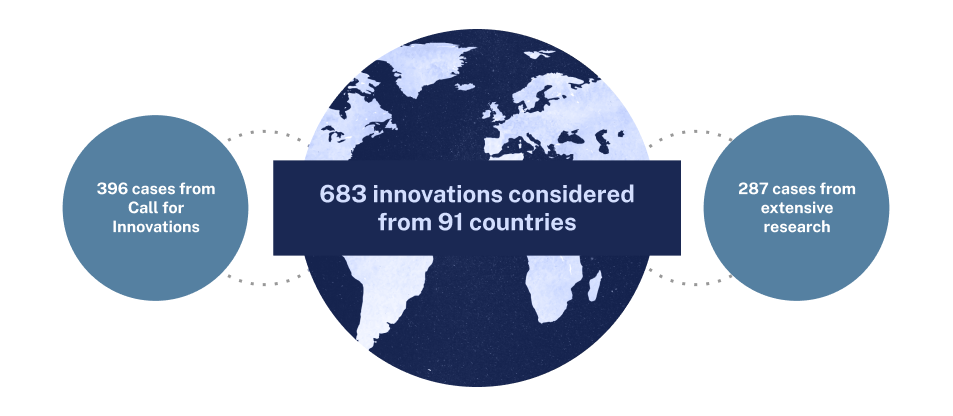Download the Report
Embracing Innovation in Government:
Global Trends 2020
The ongoing COVID-19 pandemic is an era-defining crisis that continues to unfold, capturing the attention of governments worldwide, who must grapple with its consequences for society, the economy and the future. While COVID-related efforts remain a key focus for governments, it is important to recognise the many other innovative actions that they are taking to better achieve their missions and build strong foundations for addressing present and future challenges.
OPSI and the MBRCGI have spent much of the last year working to understand how governments are confronting this challenge. We have conducted extensive research, held a global Call for Innovations crowdsourcing exercise, and met with innovative teams from around the world to surface key trends, examples and stories. Through this work, OPSI and the MBRCGI have found that governments are testing and implementing exciting and innovative new approaches, transforming the ways in which they operate and serve their people.

The second trend in this series is seamless government. Research and analysis undertaken by OPSI and the MBRCGI reveal that the most innovative countries and cities are taking action to eliminate points of friction between governments and those that they serve. This approach enables them to re-imagine the ways in which governments can collaborate and consider future scenarios. Three key themes are driving efforts in this area:
Theme 1: Invisible government
Shifting from making government an ever-present factor in people’s lives to building proactive and automated services.
Theme 2: Matrixed government
Making bureaucratic and sectoral boundaries permeable and bringing together different pieces of society in order to work together to achieve goals.
Theme 3: Anticipatory government
Exploring scenarios and taking action today to actively shape tomorrow.

Last year’s Global Trends report identified the trend, “Invisible to Visible”, referring to governments taking action to render the perspectives and insights of their people more visible. Such actions better equip policymakers to make decisions that affect their citizens. However, recent years have also seen an increasing shift towards “invisible government” where services are automated and proactive meaning people need to take no action at all to take advantage of resources.
Invisible government can take many forms, from building automated services around key life events (like childbirth or marriage) to utilizing AI-driven virtual assistants to provide information and support at scale. While these practices can reduce burdens for users and increase proactivity, they also may have unintended consequences. A lack of visibility for government might mean that citizens aren’t aware of the critical role that it plays in providing key services that they use regularly. Additionally, digital-first solutions (particularly those using AI) raise concerns around making services impersonal and potentially open to misuse.

To move the needle on its ambitious goals for 2021 and 2071 and make breakthroughs on persistent and wicked challenges, the UAE has launched the world’s first Ministry of Possibilities. This “virtual” ministry has no minister of its own and is instead guided by the Cabinet of Ministers.
It brings together individuals from across government and from other sectors to form temporary, “time-bound departments” that seek to answer impossible questions in a safe, permissible space. Each department gets up to one year to try completely new approaches, which have the potential to be scaled across government. For its initial phase, the Ministry was launched with four departments, including the Department of Proactive Services, which aims to redefine customers’ experiences of public services by anticipating needs and initiating service offerings before they are demanded.
In its first year, the Ministry has trained over 60 public sector employees in human-centred design methodology and engaged with more than 500 end users in addition to meeting most of the national public sector organisations. Ministry of Possibilities leaders also want the Ministry itself to be a replicable model, as many governments are facing the same challenges (e.g. effective services, procurement, talent, etc.). There is some evidence this is already working with government leaders in Wales proposing the creation of their own Ministry of Possibilities.

A classic criticism of the public sector is the siloed approach to government. Governments are addressing this problem by building systemic conduits and collaborative infrastructure, which will allow the creation of matrices where individuals and teams with different functions and experiences can come together to solve collective challenges.
These matrices generally corresponded to a few categories: collaboration between governments, collaboration between governments and businesses, and collaboration between governments and citizens. Through these types of innovative efforts, governments at all levels are recognising the significant transformative potential of building matrixed governments that respect, recognise and enable different ecosystems to collaborate in order to make key contributions to society.

Intangible assets such as intellectual property (IP) are of growing importance to the global economy, and often require complex technical solutions to fully unlock their potential as capital for innovation. In response to this trend, IP Australia, the Australian Government agency that administers IP rights, is working to build structures for international collaboration that enable different IP offices around the world to share digital solutions, with a view to fostering a better resourced and more efficient global IP ecosystem.
The ultimate ambition for IP GAIN is to serve as an app store, allowing different IP actors to access, share and even co-develop ground-breaking technology that solves challenges unique to, but potentially common across, the IP community worldwide. Although IP GAIN is in its early stages, the initiative has begun to demonstrate collaborative potential. When completed, IP GAIN is intended to be a worldwide platform for replicable solutions and has been created to foster collaboration around the world.

Governments often wait until a potential crisis or problem emerges before imagining solutions. This approach has far less value than anticipating and developing a response to issues before they occur. The most innovative governments are exploring beyond the horizon scanning activities and taking action today to actively shape tomorrow. In so doing, they are building seamless governments that blur the boundaries between present and future.
Of all facets of innovation, anticipatory innovation is the most underdeveloped facet of innovation, and perhaps the most difficult. It is sometimes viewed as too forward-thinking – either too disconnected from the apparent core business of an organisation or simply misunderstood. It can also challenge values by calling into question the current state of things, including peoples’ beliefs and assumptions about how the world works. Governments can overcome these challenges by picking up on weak signals through data, engaging with potential futures, designing policies and services for the future, and ultimately, bringing about new anticipatory innovation governance.

The Scenario Exploration System (SES) is a future simulation tool developed by the European Commission’s Joint Research Centre (JRC). It was developed to facilitate the application of anticipatory and futures thinking to policy making, and takes the form of a multi-role board game that encourages participants to naturally grasp complex opportunities and constraints from a future-oriented perspective.
To date, about 3 000 people worldwide have participated in a scenario exploration session on a wide range of topics and for different purposes. Available on OPSI’s Toolkit Navigator, the SES is a tool that can be used easily by policy makers (or anyone interested in exploring foresight scenarios). Instructions for use are available in 10 languages, with the tool having been used in many different contexts and cultures around the world.
These approaches have tremendous potential and may be replicated by others, although there are questions as to how this may be achieved in an effective and appropriate way. To help governments consider how they may apply them in their own contexts, they should:
Additional details on these recommendations, as well as tools and resources for achieving them, are discussed in the full report.
Governments have more potential – and more need – than ever before to provide incredible and innovative services for their people and businesses. By understanding what has been tried and learned already, and by following the recommendations in this report, governments can smooth out existing frictions in government processes and services, in internal and public-facing transactions, and in building resilient foundations for future challenges.
For governments to understand the types of innovations worth pursuing, they need to reach a better understanding of those affected by their work: citizens, residents and businesses. As seen here, the most successful examples of innovation have been designed with these individuals and organisations at the heart of the process – utilising user-centred design methods and collaboration to understand their needs.
Connections and collaborations inside and outside of government are key. Governments have a tendency over time to build organisational silos that stifle collaboration and sharing, ultimately inhibiting the flow of ideas and preventing collaborative efforts cultivate innovation. Yet, innovative governments are pushing against these structures and the cultural inertia they have created by developing collaboration conduits and ecosystems that help empower individuals and unlock the potential of broader innovation systems.
However, it is not enough to focus on reacting and adapting to the needs and challenges of today. Governments must also prepare themselves for the future, anticipating the demand for services that may be necessary but have not yet emerged – and in some cases, even shaping future possibilities to build a bright future for the generations that follow. For this approach to work, ideas must be able to permeate across organisations both inside and outside of government, and then be heard and acted upon, even when the return on investment may not be clear.
The urgency of bringing about seamless government has never been clearer. The more seamless the relationship between government actors and the broader ecosystem, the better the outcomes that governments will be able to deliver.
